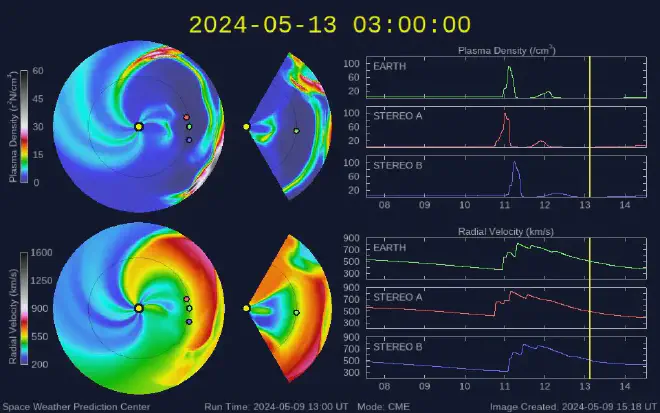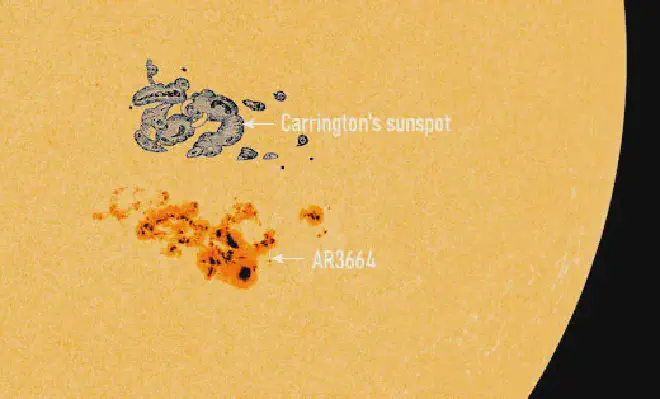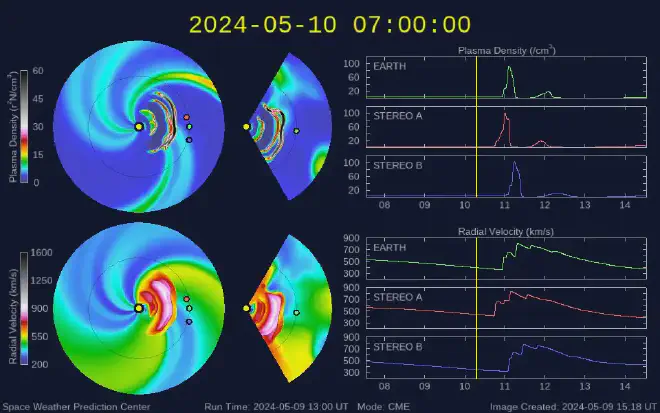

Several coronal mass ejections (CMEs) are on their way to Earth (see the movie below). A new NOAA forecasting model suggests that three of them could merge to form a powerful ‘Cannibal Coronal Mass Ejection.’ Cannibal CMEs are formed when fast-moving CMEs overtake the slower CMEs that precede them. The internal shock waves created by this type of CME collision cause geomagnetic storms when they collide with the Earth’s magnetic field. In fact, NOAA predicted a severe class storm for May 11 when the Cannibal CME arrives, according to SpaceWeather.com, under the title “Prepare for a Cannibal CME.”
“Additionally -SW indicated-, under the title Severe Geomagnetic Storm Alert, that the G3 “this weekend was updated from G2 (moderate) to G4 (severe). Why? Because the gigantic solar spot AR3664 continues to launch coronal mass ejections towards Earth. After today’s X2.2 class solar flare, there are at least 4 storm clouds heading our way.”
“Coronal mass ejection generated by the gigantic solar spot AR3664 on May 9, 2015. The CME is observed in different wavelengths by NASA’s Solar Dynamics Observatory. Image credit: SDO.”
The solar spot AR3664 #
The solar spot AR3664 is of Carrington class, titled SpaceWeather.com. The site created many years ago by Dr. Tony Phillips indicated that “the solar spot AR3664 has grown so much that it now rivals the great Carrington solar spot of 1859. To illustrate its similarity, we have added the famous Carrington sketch (to scale) to a current photograph of the Sun, obtained by NASA’s solar observatories.”

“With a span of almost 200,000 kilometers from one end to the other, AR3664 is 15 times wider than Earth. It can be observed with regular eclipse viewing glasses. Additionally, it is easy to project an image of this solar spot onto a wall, sidewalk, or white screen just as Carrington did in the 19th century.”
Carrington solar flare #
“The Carrington solar flare is famous because in August and September of 1859 it emitted a series of intense solar eruptions and CMEs. The resulting geomagnetic storms set fire to telegraph offices, melted the wires of the lines at the time, and caused auroras visible from Cuba to Hawaii. Since then, the ‘Carrington Event’ has become a touchstone of space weather in pop culture, and recent headlines stoke fears of an ‘Internet apocalypse’ (a technological blackout of modern society) if it were to happen again.”

“In fact -points out Spaceweather.com-, it could happen again. Studies suggest that Carrington-class storms occur once every 40 to 60 years, so we are overdue. But don’t worry, the four CMEs currently heading towards Earth (even combined) are unlikely to rival the monstrous CME of 1859. The Carrington Event will not happen again this weekend. However, it would be wise to monitor this growing active region while Earth is in its impact zone. Subscribe to CME impact alerts: SMS text.”
Contact: notaspampeanas@gmail.com

